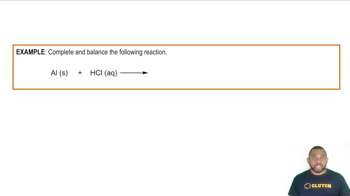Federal regulations set an upper limit of 50 parts per million (ppm) of NH3 in the air in a work environment [that is, 50 molecules of NH3(g) for every million molecules in the air]. Air from a manufacturing operation was drawn through a solution containing 1.00⨉102 mL of 0.0105 M HCl. The NH3 reacts with HCl according to: NH3(aq) + HCl(aq) → NH4Cl(aq). After drawing air through the acid solution for 10.0 min at a rate of 10.0 L/min, the acid was titrated. The remaining acid needed 13.1 mL of 0.0588 M NaOH to reach the equivalence point. (a) How many grams of NH3 were drawn into the acid solution?
Ch.4 - Reactions in Aqueous Solution
Chapter 4, Problem 124
Chlorine dioxide gas 1ClO22 is used as a commercial bleachingagent. It bleaches materials by oxidizing them. In thecourse of these reactions, the ClO2 is itself reduced. (b) Why do you think that ClO2 is reduced so readily?
 Verified step by step guidance
Verified step by step guidance1
Step 1: Identify the oxidation state of chlorine in ClO2. Chlorine dioxide (ClO2) has chlorine in a +4 oxidation state.
Step 2: Understand the concept of reduction. Reduction is the gain of electrons, which decreases the oxidation state of an element.
Step 3: Analyze the structure of ClO2. The structure shows that chlorine is bonded to two oxygen atoms, which are highly electronegative and tend to pull electron density away from chlorine.
Step 4: Consider the electron configuration and electronegativity. Chlorine, being less electronegative than oxygen, is more likely to gain electrons to achieve a more stable oxidation state.
Step 5: Conclude why ClO2 is readily reduced. Due to the high electronegativity of oxygen atoms, chlorine in ClO2 is in a relatively high oxidation state (+4) and can easily gain electrons to be reduced to a lower oxidation state, making it a good oxidizing agent.

Verified video answer for a similar problem:
This video solution was recommended by our tutors as helpful for the problem above.
Video duration:
2mWas this helpful?
Key Concepts
Here are the essential concepts you must grasp in order to answer the question correctly.
Oxidation-Reduction Reactions
Oxidation-reduction (redox) reactions involve the transfer of electrons between substances. In these reactions, one species is oxidized (loses electrons) while another is reduced (gains electrons). Chlorine dioxide (ClO2) acts as an oxidizing agent, facilitating the oxidation of other materials while itself undergoing reduction, which is crucial for its bleaching properties.
Recommended video:
Guided course

Oxidation and Reduction Reactions
Electronegativity and Bonding
Electronegativity refers to the tendency of an atom to attract electrons in a chemical bond. In ClO2, chlorine is less electronegative than oxygen, leading to a polar covalent bond. This difference in electronegativity contributes to the reactivity of ClO2, making it more likely to participate in redox reactions where it can be reduced by accepting electrons.
Recommended video:
Guided course

Electronegativity Trends
Stability of Reaction Products
The stability of the products formed during a reaction influences the likelihood of a reactant being reduced. In the case of ClO2, the reduction leads to the formation of more stable products, such as ClO− or Cl− ions. This stability drives the reaction forward, making ClO2 a readily reducible species in bleaching processes.
Recommended video:
Guided course

Production of Hydrogen Example
Related Practice
Textbook Question
Textbook Question
Federal regulations set an upper limit of 50 parts per million (ppm) of NH3 in the air in a work environment [that is, 50 molecules of NH3(g) for every million molecules in the air]. Air from a manufacturing operation was drawn through a solution containing 1.00⨉102 mL of 0.0105 M HCl. The NH3 reacts with HCl according to: NH3(aq) + HCl(aq) → NH4Cl(aq). After drawing air through the acid solution for 10.0 min at a rate of 10.0 L/min, the acid was titrated. The remaining acid needed 13.1 mL of 0.0588 M NaOH to reach the equivalence point. (b) How many ppm of NH3 were in the air? (Air has a density of 1.20 g/L and an average molar mass of 29.0 g/mol under the conditions of the experiment.)
